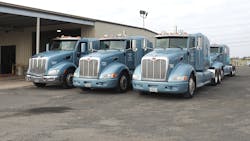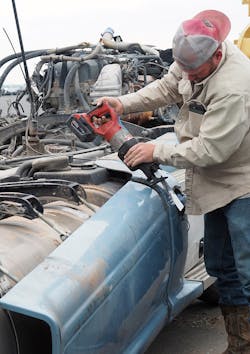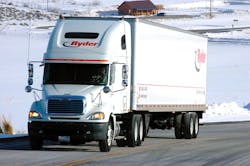When Dennis Reynolds started the tanker fleet that bears his name some 40 years ago, he believed strongly in the “do-it-yourself” ethos of truck and trailer maintenance. And it worked out very well for him.
“Up to 2007, truck and trailer maintenance remained unchanged. You really didn’t need in-depth experience to troubleshoot obvious [maintenance] problems,” explains Reynolds, founder of Reynolds Nationwide, headquartered on a 120-acre spread of ranchland just outside of San Antonio, TX. “One guy could even rebuild a [truck] engine and fix almost anything related to it, even without diagnostics.”
Nowadays, however, trucks are packed with computers that control everything from exhaust emissions to gear selection. “They’ve made things really complicated,” Reynolds says.
That’s made maintenance more intricate and expensive—especially for his fleet of 425 some-odd tractors, mainly Peterbilt Model 579 units equipped with 36-in. sleepers, and close to 1,000 trailers that haul food-grade products, milk, grain, hay, and even crude oil and rocks.
“There are computer modules all over today’s trucks,” Reynolds notes. “In the old days, you could take an engine, transmission and other pieces from an old truck, put them together with a $28,000 glider kit, and off you’d go. Now everything is proprietary, less interchangeable, and more complex with more wiring and sensors.”
To keep his upkeep costs in check, Reynolds relies on a blend of tactics drawn from both the old and new schools of truck and trailer maintenance.
On the old school side, he employs a team of 25 technicians and body repair experts operating out of four maintenance bays at his San Antonio compound. Not only do they handle light maintenance work (oil changes, trailer landing gear repairs, etc.), they also rebuild trucks bought at salvage auctions—even going so far as to cannibalize older units to keep others up and running in good repair.
"We can buy even a one-year-old tractor sometimes for $8,000 from salvage and bring it back to life as long as the wiring isn’t shredded."
- Dennis Reynolds, founder of Reynolds Nationwide
“We do everything but frame straightening,” Reynolds says. “We can buy even a one-year-old tractor sometimes for $8,000 from salvage and bring it back to life as long as the wiring isn’t shredded. If the harnesses are torn up, we can’t use it.”
But when it comes to engine and transmission diagnostics and other computer-related work, Reynolds will outsource that to his Rush Truck Centers dealer.
“We don’t have specific guys who work on engine electronics; you’ve got to be like a surgeon to work on that,” he says. “So for major repairs and specialty work, we’ll go to Rush. We just don’t have the technical people on hand for that.”
Yet Reynolds notes that in many cases, the latest 2017-model trucks he’s bringing into his fleet are getting less complex compared to 2013 and 2014 models. Not only has maintenance been simplified, but there are more diagnostic benefits.
“When electronics came into the engine, that’s like when the gloves came off. It was like the Apollo race was on, with ever more wiring and sensors,” he says. “Now, though, with the 2017 models, there’s 75% less wiring and sensors. It’s getting easier.”
Dart’s data plan
Paul Mages, who heads up the “efficiency team” at Eagan, MN-based TL carrier Dart Transit Co., says a key part of making truck maintenance “easier” is getting a “heads up” regarding potential problems before they leave a tractor-trailer stranded on the side of the road. And that is where remote diagnostics is coming more strongly into play.
Dart equipped its 300 or so Kenworth T680s with the OEM’s TruckTech+ system in 2016, and Mages says its data is helping reduce downtime, especially when it comes to “re-gens” required by diesel particulate filters.
“Before, the truck [engine] could be de-rated if a driver overlooked an alert or waited too long to clean the emissions system, especially after the truck had been sitting over a rest period,” he explains. “Now, we get an email notification when the soot level gets to a critical point and can call the driver and get action taken before a de-rate takes place.
“If we see the truck idling in stop-and-go traffic or at a truck stop, we can instruct him to park the truck and start the re-gen process, something that takes between 15 and 30 minutes,” Mages continues. “If we see the driver on the freeway, we know that the re-gen can take place automatically.”
The amount of information and detail provided to Dart’s call center via the TruckTech+ remote diagnostics is taking the maintenance “guesswork” out of roadside issues. “It’s not so much a roll of the dice anymore,” he explains. “We would always want to err on the side of caution when it comes to trucks and use our gut feeling whether to continue on or shut the truck down completely. The codes and information we’re now receiving enable us to make informed decisions.”
In terms of maintenance cost savings, Mages says Dart gained some fast bottom-line benefits: significantly reducing tow truck calls in 2016. “We figure each tow costs between $1,500 and $2,000 when you factor in the cost of the tow, the repair, and lost utilization,” he says.
Such diagnostic data is no longer limited to just engines. Late last year, for example, component maker Detroit, a division of Daimler Trucks North America (DTNA),extended the number of fault codes monitored by the Virtual Technician integrated remote diagnostic system to include those generated by the safety technologies grouped within its Detroit Assurance suite of systems.
Available on all Freightliner Cascadia and Cascadia Evolution trucks equipped with Detroit-branded engines, Detroit Assurance is integrated into a truck’s engine, transmission, and exhaust aftertreatment system as well as the braking system and dashboard to enhance driver safety.
“We are not just expanding the number of faults monitored by Virtual Technician, we are further integrating our connectivity offerings with the rest of the Detroit product lineup,” explains Matt Pfaffenbach, DTNA’s director of telematics. “This furthers the reach of connectivity within the truck and delivers additional value to the customer, who can then make better decisions regarding their business by utilizing such information.”
Better analysis
Gregg Mangione, senior vice president of maintenance for Penske Logistics, notes that the ability to access more detailed truck data faster, in real-time, should also help OEMs build better products in the long run.
“Two key areas that are changing and will continue to change are the warranty chain and the triage or intake [for maintenance],” he says. “OEMs, and specifically their engineers, have latched onto the ability to receive fault code data in near real time as a way to see into the performance and reliability of their products. This has accelerated their ability to improve their products.”
Mangione says that for years, Penske Logistics, as a large maintenance provider, would perform its own “failure analysis” on a regular basis to gauge vehicle and component reliability and share any issues with OEMs for early intervention, containment and repair.
“That analysis was dependent on repair order data, which can have a lag of a couple months when you consider processing,” he explains. “At the same time, OEMs have always used warranty data the same way. But now you add the additional lag of filing warranty and the data adds another 60 days, so you are analyzing three- to four-month-old data in an effort to identify emerging issues.”
Remote diagnostics turns that on its head, notes Mangione. “Now, you are analyzing fault code data in days, and that data can inform both electrical and mechanical conditions,” he explains. “There is still regular warranty analysis, but maintenance providers and OEs can sense and respond to vehicle reliability issues much more quickly as we see the proliferation of onboard telematics and data feeds coming from vehicles.”
“The use of big data to more proactively understand fault code severity and provide guidance on condition (usage) based maintenance is a very important part of the overall service and repair strategy across the industry,” adds Michael Riemer, vice president for Product & Channel Marketing at Decisiv.
Riemer highlights the “end-to-end closed-loop process” deployed by Mack Trucks, Volvo Trucks and Hino Trucks as examples of how remote diagnostics systems on board today’s trucks can deliver “actionable data, meaningful alerts, and true collaboration” by integrating the OEM’s call center, the OEM’s dealers and fleet customers.
Such systems take “intelligence” gleaned via “big data analysis” of engine performance and fault codes—measured by severity and recommended repair plans—and combine it with “business rules” on who to contact/alert in case of trouble along with automatic “case creation” between fleets and OEM call centers.
“They [Mack and Volvo] have reported [maintenance] triage reductions greater than 70%, downtime decreases by more than 20%, and a 90% improvement in first-time fixes,” Riemer says.
He stresses that there is a difference between “big data” and just having “lots of data” on hand.
In many cases, fleets have lots of data of poor quality, gathered well after the fact, on hand-entered invoices with poor VMRS (vehicle maintenance reporting standards) coding, paper inspection forms transcribed with errors, limited oversight on external repairs, plus extended downtime.
Navistar is trying to go a step further by creating what Andrew Dondlinger, vice president and general manager of connected services, calls an “open telematics ecosystem” on board its vehicles to give customers the ability to “plug in” a variety of functions, such as automatic pre- and post-trip inspection checklists, right into its vehicles without the need to add extra electronic hardware.
In essence, he says Navistar will be adding the equivalent of a “universal cable TV box” to its trucks. This “box” should be able to host any type of telematics programming via any type of provider, and fleets or owner-operators should not need to switch out hardware in order to switch providers.
“The coming years are really going to be exciting,” Dart’s Mages says. “As the trucks we have with remote diagnostics age, the information the trucks provide will allow us even better decision making and cost savings,” he says, allowing Dart to collect “a vast amount of data” and use it for trend analysis.
“Plus, we’re going to integrate remote diagnostics into our fleet maintenance software,” Mages explains. “I can’t wait to see where all of this is in five years from now. I’m really looking forward to seeing how it all plays out.”
Preventive maintenance for fuel
It won’t be long before spring makes its annual approach, so it’s worth remembering that cold weather can create a variety of maintenance problems, particularly when it come to diesel fuel.
Bill Dawson, vice president of maintenance operations and engineering for Ryder System, explains that having the “wrong fuel” in diesel-powered trucks during cold weather can put fleets and drivers alike at risk.
“But being prepared for harsh winter temperatures doesn’t just begin with the fuel you put in your tanks,” he stresses. “Proper maintenance of vehicle fuel tanks is an essential part of achieving a trouble-free, lower-cost winter operation.”
As most fleets know, diesel fuel is prone to “waxing” or “gelling” in cold weather. These terms describe the “solidification” of diesel into a partially crystalline state. The wax particulates in the fuel give it a cloudy appearance and can clog fuel filters and injectors in engines, which also build up in the fuel line and fuel filters until the engine gets “starved” of fuel and causes it to cease operation.
Most diesel fuel in the U.S. is now ultra-low sulfur diesel (ULSD), with a sulfur content of 15 ppm or less. And while the lower sulfur content of ULSD helps improve air quality, it also presents some special challenges that need to be addressed when preparing for cold temperature operations.
Dawson cites a few preventive maintenance measures fleets can follow to improve the operation of diesel-powered vehicles in winter:
- Fuel additives—When temperatures drop to below 20 deg. F, add a diesel fuel anti-gel additive to your fuel tanks.
- Winter blend fuel—Ensure you have quality winter blended fuel in your tank. Typically, that means using a No. 1 diesel blend to which kerosene is added, lowering the fuel’s cold filter plugging point (CFPP) to -40 °F. No. 1 diesel is more expensive than the standard No. 2 grade, so a small amount of No. 1 is usually mixed into No. 2. Adding 10% of No. 1 diesel usually lowers the CFPP temperature of No. 2 diesel by about 5 deg.
- Fuel tank level—Keep your fuel tank half full. In extremely cold temperatures, condensation can build up in a near-empty fuel tank, which can cause fuel line freeze-up and no-start conditions.
- Planning ahead—Think about where “the coldest point” is that your trucks will travel to during the winter months, then treat your fuel and plan accordingly to those expected temperatures.
About the Author
Sean Kilcarr
Editor in Chief
Sean Kilcarr is a former longtime FleetOwner senior editor who wrote for the publication from 2000 to 2018. He served as editor-in-chief from 2017 to 2018.





